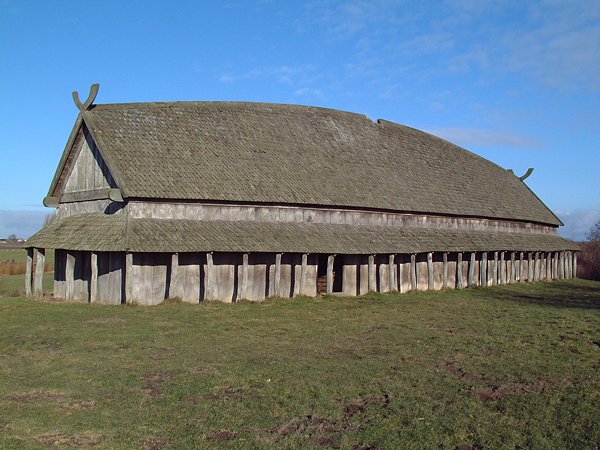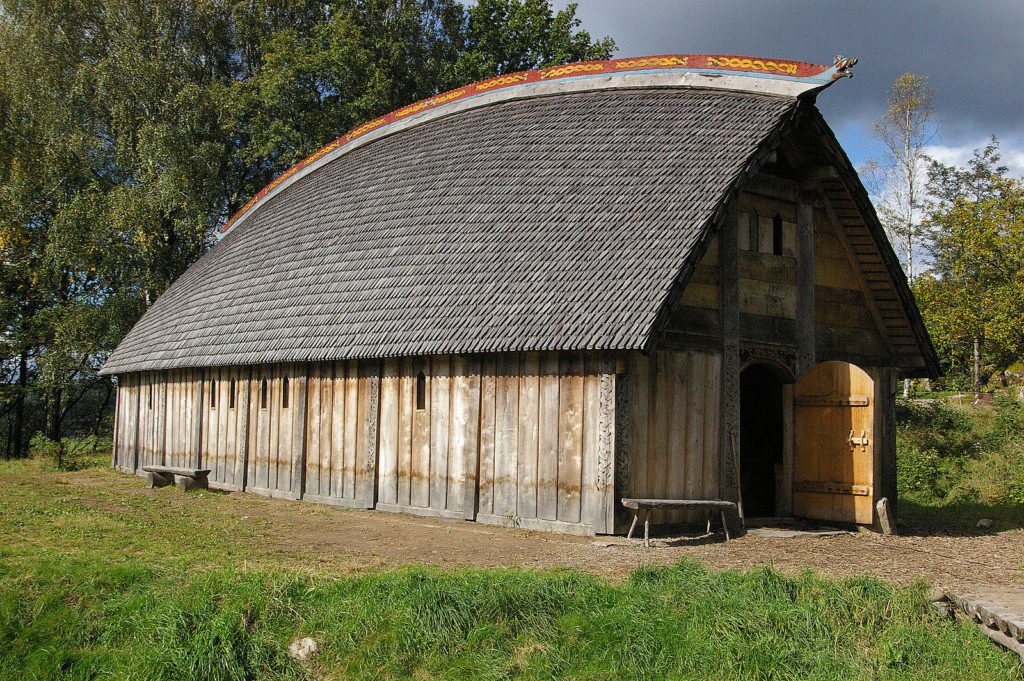Last updated on January 27th, 2023 at 07:29 pm
Every schoolchild is familiar with tales of the ferocious Vikings who terrorized Europe for over two centuries from their first raids on Britain in the final years of the eighth century.
Striking against coastal targets in their longships and making off with riches and slaves, they were soon pillaging much of Western Europe and voyaging as far west as Greenland and Newfoundland and southeast towards the Caspian Sea and Constantinople.
Eventually, they carved out Dublin, East Anglia, and Normandy territories. Yet we know less about how the Vikings lived back home in Norway, Denmark, and Sweden. In particular, one rarely hears much about life in the average Viking Longhouse. These dwellings were central to Norse culture and society at the height of the Viking Age between the eighth and eleventh centuries.

What Were Viking Longhouses?
As the name would suggest, Viking Longhouses were long but thin houses. Typically speaking, they were about five to eight meters wide. However, their length could vary immensely depending on who the house was built for.
The average Viking’s Longhouse was a modest dwelling, perhaps about 15 to 20 meters long. Those of a Viking warlord or a jarl, the name given to the head of a Viking community that later became the basis for the noble title of earl, could stand up to 70 or 80 meters long.
These were effectively great halls that could accommodate scores of people during banquets and other social gatherings, the equivalent of a later feudal castle in Viking terms. Most Longhouses were constructed of timber frames with wattle and daub walls and thatched rooves.
However, some had wooden roofs, and the design was often vernacular, which utilized whatever building material was most readily available in a given area.
What was it like inside a Viking Longhouse?
The purposes that a Longhouse might serve again varied according to its nature and the social status of those living there. Smaller Longhouses were dwelling houses for a family and maybe some extended kinship group members.
The house was dominated by a long central hall, along the sides of which were benches serving as beds. In the center was a great hearth that heated the home.
Larger Longhouses would have had several smaller rooms off the main chamber and perhaps several hearths. Whatever their size, most Longhouses would have had separate rooms at the far ends of them, which would have served as storerooms and stables for animals to protect them against the harsh Scandinavian winter.

The cold was also why Longhouses typically did not have windows of any kind. Instead, the great hearth lighted most in the middle of the central chamber. As a result, these buildings were smoky environments. A lot of this was relieved by a hole in the roof above the central fireplace. This feature allowed smoke to drift out directly from the hearth.
They kept the central fire burning or at least smoldering almost continuously. Some recent archaeological studies have suggested that Viking Longhouses included primitive toilets, but this evidence is very slim, and people almost certainly went outside to relieve themselves.
What was life like in the Viking longhouse?
Feasting and communal dining were central to life in the Longhouses. The diet of the Vikings was heavily protein and fat-based.
Large amounts of fish were consumed, hardly a surprise given the Vikings’ status as people who lived on the coast and spent much of their lives at sea. A lot of meat and dairy were also consumed, though porridge and bread were also popular foods for poorer Vikings.
The cereals for staple foodstuffs such as these would have been grown by enslaved people or ‘thralls,’ which were numerous in Norse society. Slaves often lived in the Longhouse, generally in a chamber set aside quite nastily for them next to the stable.
The culture predominated within the Longhouse was similar to the Germanic societies that had conquered the Western Roman Empire between the third and fifth centuries AD.
The Vikings, for instance, spoke Old Norse, a North Germanic language out of which the modern-day tongues of Norwegian, Danish, and Swedish eventually evolved.
This was the tongue in which the Norse people gave renditions of their great sagas and lore, which would have been related by poets and storytellers at banquets within the jarl’s Longhouse in an average Viking settlement.
These oral poems and epics were passed down from generation to generation and were only eventually written down from the tenth century onwards.
Religion was not absent from the life of the Longhouse. The Vikings were polytheists, meaning they worshipped a pantheon of multiple gods similar to those the Greeks and Romans had worshipped centuries before Christianity overtook paganism in southern and western Europe.
The Norse religious landscape consisted of dozens of gods and demi-gods, both male and female. The two most significant of these were Odin and Thor.
Odin was the father of the gods and was typically depicted as a one-eyed, older man wearing a cloak and holding a long staff. He had dominion over death and healing. In Norse mythology, he presided over an enormous celestial hall called Valhalla, to which great Viking warriors would be called forth in the afterlife.
As revered as Odin was, his son Thor, the Norse god of war, was even more esteemed. This was hardly surprising for militaristic people, and Thor is typically seen wielding his famed war hammer known as Mjölnir.
What was the overall standard of living?
Overall a Viking Longhouse was not a bad place to live by the standards of the Early Middle Ages, at least if you weren’t a slave in one of them.
The crowded building would have depended on the time of year and the community involved. For instance, as the Vikings began raiding Western Europe every spring and summer in the ninth century, the Longhouse would have had fewer denizens as the men left.
This development suggests that the slaves and thralls would have been treated somewhat better than one might think to avoid revolts while the adult male population was elsewhere.
Thus, there was perhaps a greater degree of harmony within the cramped environment of a Viking Longhouse than one would initially think.
These buildings remained in use in Scandinavia for centuries to come. Such was their practicality in an environment with harsh winters. Indeed buildings of this kind remain in use in cold, mountainous regions such as those found in Himalayan countries like Tibet and Nepal down to the present day.
Sources
Cara E. Richards, ‘Of Vikings and Longhouses’, in American Anthropologist, Vol. 60 (1958), pp. 1199–1203.
Kirsten Wolf, Daily Life of the Vikings (Connecticut, 2004).
Stefan Brink, ‘Who were the Vikings?’, in Stefan Brink and Neil Price (eds.), The Viking World (London, 2008); John Marsden, The Fury of the Northmen: Saints, Shrines and Sea-Raiders in the Viking Age (London, 1993).

